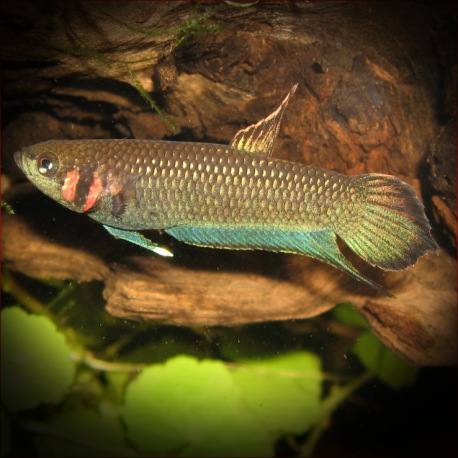More info
Datasheet
| Minimum Tank Size | 60 litres / 15.85 US gallons |
| Maximum Size | 6.0cm / 2.36inches |
| Temperature | 22°C / 71.60°F - 27°C / 80.60°F |
| Hardness | 1.01dgH / 18ppm - 5.04dgH / 90ppm |
| pH | 4.0-6.5 |
General Description
Betta Mandor, previously known as B. sp. ‘Mandor’ or B. sp. ‘ninja’, belongs to the Betta foerschi group within the genus Betta. It boasts iridescent blue or green unpaired fins, a thin white band on the dorsal fin, and two reddish-yellow bars on the opercle. This species is closely related to bubble-nesting Betta species, exhibiting similar morphological features and reproductive strategies. Betta Mandor is a paternal mouthbrooder, and individuals can reach a maximum size of 6.0cm.
Aquarium Setup
Betta Mandor thrives in a decorated aquarium without substrate to ease maintenance. Driftwood, roots, branches, clay pots, and leaf litter provide shelter and cover. Alder cones and dried leaves aid in microbe colony growth and offer a secondary food source. Soft, acidic water with minimal carbonate and general hardness levels is essential, requiring gentle filtration and dim lighting. Aquatic plants like Microsorum and floating vegetation are recommended, along with a partial cover to allow access to humid air above the water surface.
Behaviour
This species is best kept alone or with peaceful tank mates, as larger or more aggressive fish may intimidate or outcompete Betta Mandor. While some suggest maintaining multiple pairs or harem-type groups, aggression towards conspecifics by dominant individuals can occur. Breeding pairs may become distracted by the presence of other fish, affecting their spawning behavior.
Feeding and Diet
Betta Mandor feeds primarily on insects, small invertebrates, and zooplankton in its natural habitat. In captivity, they accept dried foods but require live or frozen options like Daphnia, Artemia, and bloodworms. Offer small amounts of varied foods multiple times a day, ensuring not to overfeed as they are prone to obesity.
Reproduction & Dimorphism
During reproduction, male Betta Mandor wrap their bodies around females in an embrace, with females carrying the eggs. Males collect the eggs in their mouths, where they are brooded until hatching. Fry can consume microworms and Artemia nauplii immediately, with care taken not to overfeed. Males display more vibrant colors and extended fins compared to females, with distinct opercular bar coloration differences.
Habitat and Distribution
Endemic to the lower Kapuas River basin in West Kalimantan, Indonesia, Betta Mandor is found in forest swamp streams with minimal light penetration and a substrate of fallen leaves and branches. These environments feature negligible dissolved minerals, low pH levels, and thick marginal vegetation. Threatened by illegal logging activities, preservation efforts are crucial for the species' survival.

